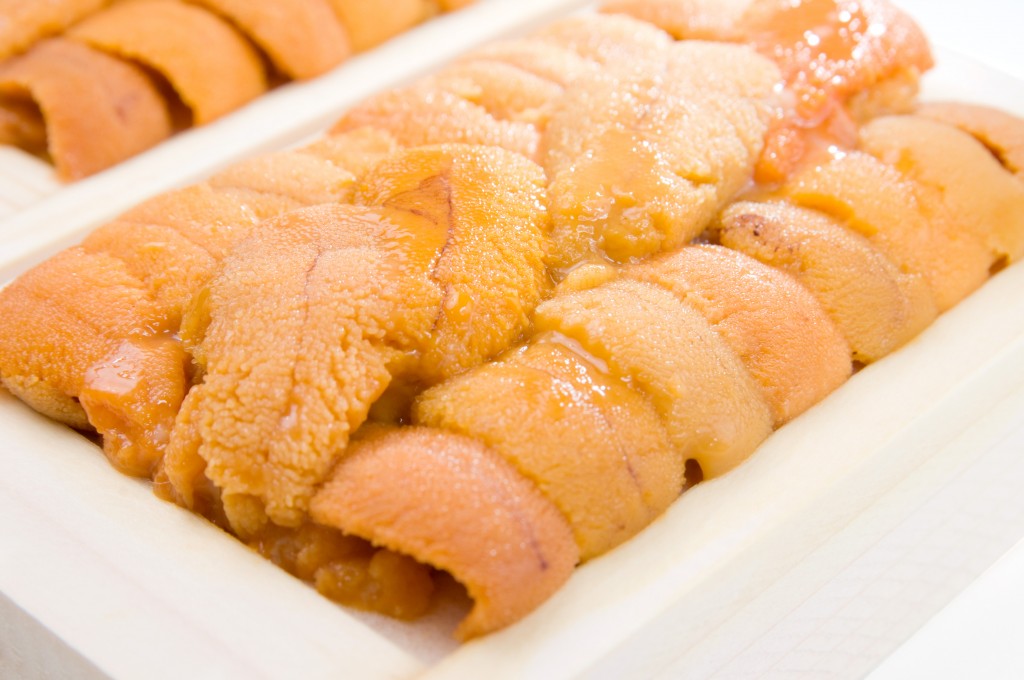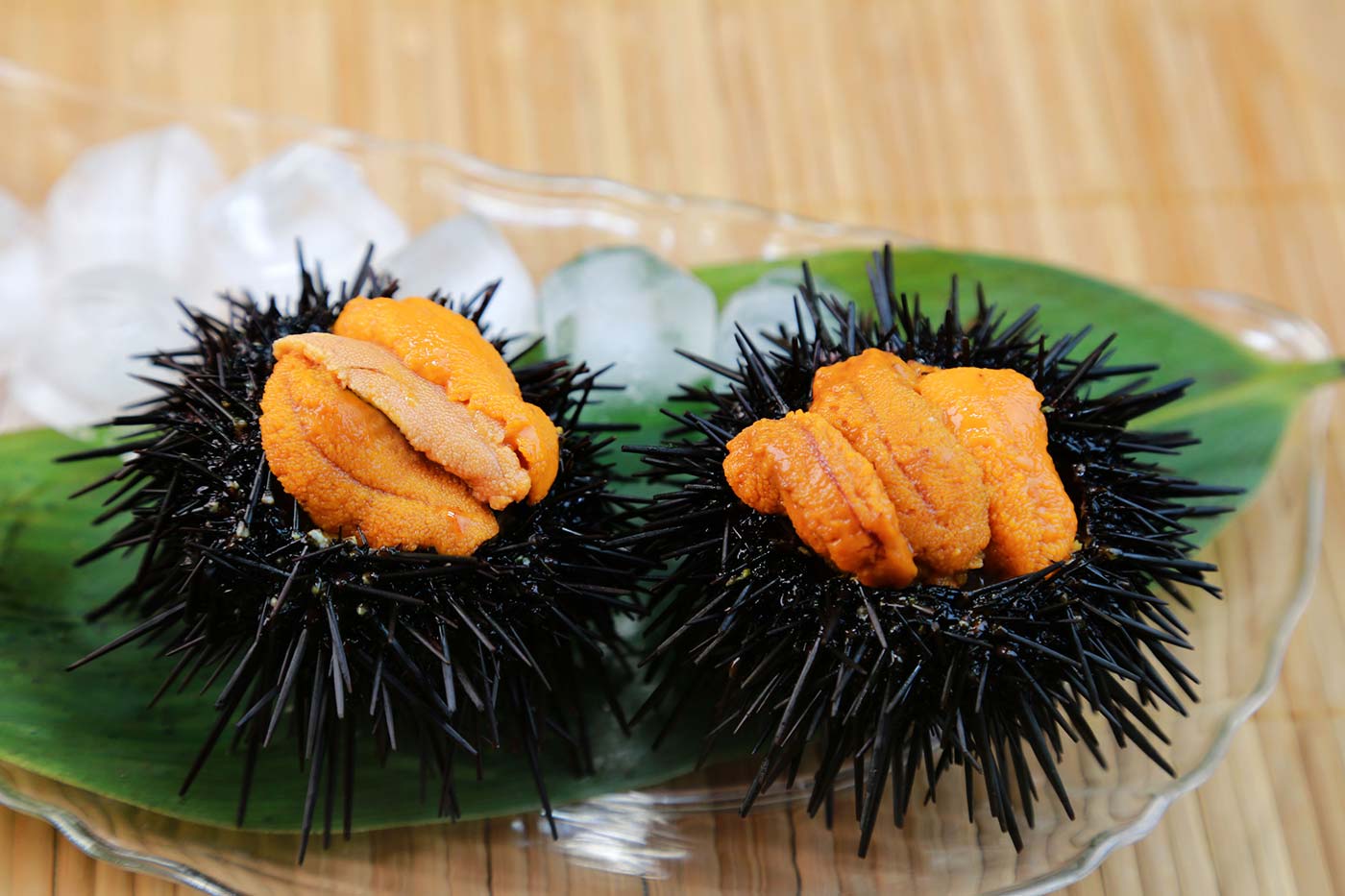Uni: Dive Into The World Of Sea Urchin Delicacy
Ever wondered what culinary treasure lies beneath the spiky exterior of a sea urchin? Uni, the creamy, flavorful, and highly prized edible part of this marine creature, is a delicacy that tantalizes taste buds around the world.
Uni, in essence, is the gonads of the sea urchin. This seemingly simple fact belies a world of complex flavors, textures, and nuances that have captivated chefs and gourmands for centuries. The journey of uni from the ocean floor to your plate is one of meticulous sourcing, careful handling, and an appreciation for the delicate balance of nature's bounty.
The allure of uni extends beyond its exquisite taste. It's a sensory experience, a moment of pure indulgence that transcends mere sustenance. The best uni, sourced from pristine waters and prepared with artistry, offers a glimpse into the very soul of Japanese cuisine and the global culinary landscape.
Uni, a name that may sound foreign to some, is a culinary term that evokes images of the finest sushi restaurants and the most discerning palates. But what exactly is it? How is it enjoyed? And what makes this ingredient so special?
Uni, often referred to as sea urchin roe, is more accurately the gonads of the sea urchin. While the term "roe" is commonly used, it's important to understand that uni is not the eggs but rather the reproductive organs of the sea urchin. These organs, ranging in color from pale yellow to deep orange, are prized for their creamy texture, rich flavor, and subtle sweetness. This delicacy has become a staple of Japanese cuisine, celebrated for its unique taste and versatility.
The world of uni is surprisingly diverse. With over 950 species of sea urchins found across the globe, only a select few are considered edible. Of these, the two most celebrated varieties in Japan are Murasaki uni and Bafun uni.
Murasaki uni, with its delicate yellow color and subtly sweet flavor, is often considered the epitome of uni. Its flesh is firm yet melts in the mouth, offering a clean taste of the sea. Bafun uni, on the other hand, is known for its darker color, often a rich brown, and its more intense, briny flavor. The name "Bafun" itself refers to the color, which is said to resemble horse manure. Despite the less-than-appetizing comparison, Bafun uni is highly prized for its robust flavor and unique texture.
Beyond these two popular types, many other varieties of uni exist, each with its unique characteristics. The taste of uni is remarkably variable, influenced by factors like the sea urchin's diet, the season in which it is harvested, and the specific location of its habitat. This variability is part of what makes uni so exciting; each encounter is a new discovery.
The quest for the perfect uni begins with sourcing. Expert suppliers and restaurants go to great lengths to procure uni from the best locations, focusing on the freshness, texture, and overall quality of the product. Uni is graded based on its appearance, texture, and flavor, with the finest grades commanding premium prices. The grading system often includes designations like "AAA" for the highest quality, "AA" for excellent, and "A+" for great.
Once the uni has been harvested and graded, it requires careful handling to maintain its delicate flavor and texture. Uni is typically served fresh, often as nigiri sushi, where a piece of uni is gently placed atop a bed of vinegared rice. It can also be enjoyed in sashimi, pasta dishes, and even hotpots.
Uni's versatility in the kitchen allows it to be incorporated into a wide range of culinary creations. It's not just a topping for sushi; it can be the star of a dish. From uni pasta to uni toast, the possibilities are endless. The creamy texture and rich flavor of uni add a touch of luxury to any meal.
The preparation of uni, particularly in traditional Japanese cuisine, is an art form. The sushi rice is prepared with precision, ensuring the perfect balance of texture and flavor. The uni is carefully placed, often with a touch of wasabi to enhance its natural sweetness. The result is a masterpiece of simplicity and elegance.
The popularity of uni sushi is ever-changing, especially with the rise in popularity of the Santa Barbara uni variety. Because of its large size, uni sushi is adapting to this change.
Uni, a premium ingredient for sushi and sashimi, is a testament to the artistry of Japanese cuisine and the value placed on fresh, high-quality ingredients. The flavor of uni is highly variable, depending on the diet, season, and location. It can be prepared in many dishes, such as pasta, sushi, and toast.
The world of uni is not just about taste; it also offers potential health benefits. While specific research is still ongoing, uni is a source of essential nutrients, including omega-3 fatty acids, which are known for their heart-healthy properties. It also contains vitamins and minerals, making it a nutritious addition to a balanced diet.
Beyond its culinary applications, uni has a rich cultural significance. It is often associated with special occasions and celebrations, representing a symbol of luxury and refinement. The careful preparation and presentation of uni dishes reflect a deep respect for the ingredients and a commitment to culinary excellence.
From the bustling fish markets to the elegant sushi counters, the journey of uni is a captivating story of nature, craftsmanship, and culinary artistry. It is an experience that ignites the senses and leaves a lasting impression.
The selection of the right uni begins with understanding the different types and grades available. Seasonality plays a crucial role, with peak seasons varying depending on the region and the specific type of uni. The appearance is a key indicator of quality. Look for uni that is vibrant in color, with a firm texture and a fresh, clean aroma.
Storage is also critical to preserving the quality of uni. Uni should be stored properly to maintain freshness and prevent spoilage. Fresh uni should be stored in the coldest part of the refrigerator, wrapped tightly to prevent it from drying out. It is best consumed within a few days of purchase.
Whether you're a seasoned sushi aficionado or a curious newcomer, the world of uni is a fascinating realm to explore. Its unique flavor profile, coupled with its cultural significance and health benefits, makes it a truly remarkable ingredient. With its many varieties and cooking methods, you are sure to find a uni dish that suits your taste.
Japanese uni is smaller than those in Santa Barbara, so gunkan work worked the best. A few buttery uni are layered on top of the sushi rice with a tiny bit of wasabi placed on top. An uni sushi nigiri is not only a treat, but also a sight to behold.
To truly appreciate uni, it's important to embrace the sensory experience. Take your time, savor each bite, and allow the flavors and textures to unfold. Experiment with different pairings, such as a glass of chilled sake or a crisp white wine, to enhance the dining experience. Whether you're enjoying it in sushi, sashimi, or another dish, uni is a treat that should be savored.
The increasing popularity of uni has led to the development of innovative dishes and cooking techniques. The creativity and artistry of chefs are constantly pushing the boundaries of uni cuisine. The evolution of uni sushi is a testament to the ingredient's versatility.
If you're looking to experience uni in a restaurant, be sure to do your research. Look for restaurants that specialize in Japanese cuisine and have a reputation for sourcing high-quality ingredients. Check reviews and ask for recommendations to ensure that you are getting the best possible experience.
The world of uni is ever-changing, with new varieties, cooking methods, and culinary innovations constantly emerging. By staying curious and exploring the diverse world of uni, you can deepen your appreciation for this extraordinary ingredient.
The best quality reflects the best uni available at each day's market. It is grown in other regions in Japan as well, so it's one of the most common uni varieties in Japan. Ezo bafun uni boasts a robust flavor, intense umami, and sweetness.
The meticulous preparation of uni and the dishes made with it, requires skill and respect for the ingredients. The delicate dance between flavor and texture elevates uni to a culinary art form. Whether it's the preparation of uni japanese style, or the way it is presented as uni sushi nigiri, it is both a treat and sight of the finest culinary art.
The Uni Mitsubishi Pencil Company of Japan is headquartered in Tokyo, Japan, and was originally established in 1925. Uni's corporate philosophy is that the best quality is the best service. And has produced some highly popular product lines over the years. While not directly related to the culinary use of Uni, the company's pursuit of best quality is analogous to the standards required to properly appreciate uni as a culinary ingredient.
The journey of uni is a testament to the power of culinary exploration. From the depths of the ocean to the tables of the world's finest restaurants, uni offers a unique and memorable dining experience. So, the next time you encounter this prized delicacy, embrace the opportunity to savor its flavors and appreciate the artistry that brings it to your plate.
The taste of uni is actually highly variable, depending on its diet, season, and location. To cook the Japanese uni style, wash the sushi rice until the water comes out clean, then use the same amount of water as rice. Cook over medium heat, then lower the heat and let the rice boil. Whether you enjoy it in sushi, sashimi, or as part of a more complex preparation, take the time to experience the nuances of the dish.
When considering where to experience uni, the options range from small, intimate sushi bars to renowned restaurants. The atmosphere, the skill of the chef, and the sourcing of the uni will all contribute to the quality of the dining experience. A sashimi bowl omakase, a chef's choice assortment of the freshest fish, and a selection of nigiri are all ways to explore the different facets of uni.
The process of experiencing uni is a journey of discovery. Each bite offers a glimpse into the world of flavor, texture, and cultural significance. Embrace the opportunity to savor this delicacy and appreciate the artistry that brings it to your plate.
The preparation of uni can be a rewarding experience. Once you understand the basics, you can make uni sushi, try it in pasta, toast, or explore other creative applications. By exploring the flavors and the textures of uni, one can appreciate the rich culture of Japanese culinary tradition.
The import of different grades and brands of uni from japan, usa, canada, and other territories shows its popularity and versatility. So whether you are a first-time explorer of the culinary world or a seasoned food lover, discover the versatility of uni in Japanese cuisine.
Uni, the edible part of sea urchin, stands as a testament to the wonders of Japanese cuisine. The creamy and flavorful seafood is both healthy and versatile. Discovering the different types, grades, and flavors of uni will enhance the experience.
Uni is not just a delicacy, it is a connection to the ocean and the skilled artisans who bring this treasure to our tables. It is an ingredient that deserves to be explored, appreciated, and savored. When the ingredient is prepared in Japanese style with care, it transforms into a culinary masterpiece.
The journey of uni is a celebration of the senses and an exploration of the diverse flavors that the sea has to offer.


